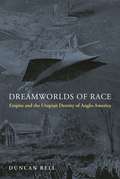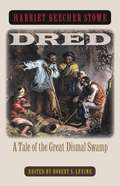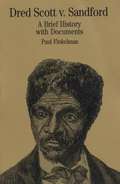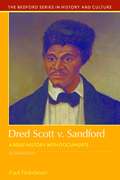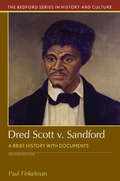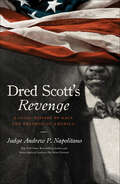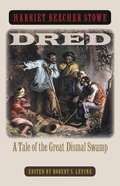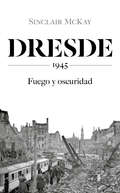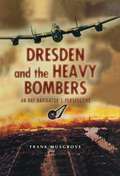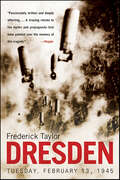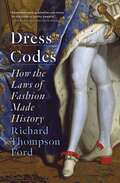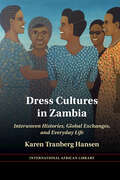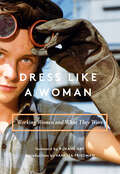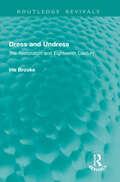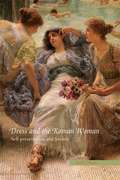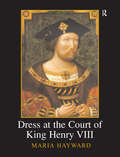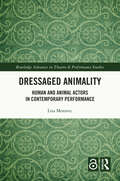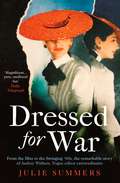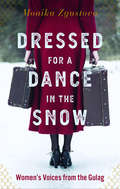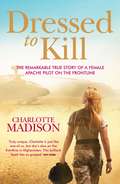- Table View
- List View
Dreamworlds of Race: Empire and the Utopian Destiny of Anglo-America
by Duncan BellHow transatlantic thinkers in the late nineteenth and early twentieth centuries promoted the unification of Britain and the United StatesBetween the late nineteenth century and the First World War an ocean-spanning network of prominent individuals advocated the unification of Britain and the United States. They dreamt of the final consolidation of the Angloworld. Scholars, journalists, politicians, businessmen, and science fiction writers invested the “Anglo-Saxons” with extraordinary power. The most ambitious hailed them as a people destined to bring peace and justice to the earth. More modest visions still imagined them as likely to shape the twentieth century. Dreamworlds of Race explores this remarkable moment in the intellectual history of racial domination, political utopianism, and world order.Focusing on a quartet of extraordinary figures—Andrew Carnegie, W. T. Stead, Cecil J. Rhodes, and H. G. Wells—Duncan Bell shows how unionists on both sides of the Atlantic reimagined citizenship, empire, patriotism, race, war, and peace in their quest to secure global supremacy. Yet even as they dreamt of an Anglo-dominated world, the unionists disagreed over the meaning of race, the legitimacy of imperialism, the nature of political belonging, and the ultimate form and purpose of unification. The racial dreamworld was an object of competing claims and fantasies. Exploring speculative fiction as well as more conventional forms of political writing, Bell reads unionist arguments as expressions of the utopianism circulating through fin-de-siècle Anglo-American culture, and juxtaposes them with pan-Africanist critiques of racial domination and late twentieth-century fictional narratives of Anglo-American empire.Tracing how intellectual elites promoted an ambitious project of political and racial unification between Britain and the United States, Dreamworlds of Race analyzes ideas of empire and world order that reverberate to this day.
Dred
by Harriet Beecher StoweHarriet Beecher Stowe's second antislavery novel was written partly in response to the criticisms of Uncle Tom's Cabin (1852) by both white Southerners and black abolitionists. In Dred (1856), Stowe attempts to explore the issue of slavery from an African American perspective.Through the compelling stories of Nina Gordon, the mistress of a slave plantation, and Dred, a black revolutionary, Stowe brings to life conflicting beliefs about race, the institution of slavery, and the possibilities of violent resistance. Probing the political and spiritual goals that fuel Dred's rebellion, Stowe creates a figure far different from the acquiescent Christian martyr Uncle Tom. In his introduction to the classic novel, Robert S. Levine outlines the antislavery debates in which Stowe had become deeply involved before and during her writing of Dred. Levine shows that in addition to its significance in literary history, the novel remains relevant to present-day discussions of cross-racial perspectives.
Dred Scott V. Sandford: A Brief History with Documents
by Paul FinkelmanPerhaps no other Supreme Court decision has had the political impact of "Dred Scott v. Sandford," Using a variety of documents that reflect regional opinions and political debates, Paul Finkelman examines the 1857 decision that helped set in motion the events that eventually led to a new birth of freedom and the abolition of slavery in the United States.
Dred Scott v. Sandford: A Brief History with Documents
by Paul FinkelmanPerhaps no other Supreme Court decision has had the political impact of Dred Scott v. Sandford. Using a variety of documents that reflect regional opinions and political debates, Paul Finkelman examines the 1857 decision that helped set in motion the events that eventually led to a new birth of freedom and the abolition of slavery in the United States. A revised Introduction reveals new understandings of the case and recently discovered evidence about Dred Scott, his wife Harriet, his owners, his lawyers, and the history of freedom suits in Missouri. New text sources include President James Buchanan's inaugural address and the post-Civil War Amendments, which collectively reversed the major holdings in Dred Scott. This new edition also contains Questions for Consideration, an updated Selected Bibliography, and a Chronology of Events Related to Dred Scott.
Dred Scott v. Sandford: A Brief History with Documents
by Paul FinkelmanPerhaps no other Supreme Court decision has had the political impact of Dred Scott v. Sandford. Using a variety of documents that reflect regional opinions and political debates, Paul Finkelman examines the 1857 decision that helped set in motion the events that eventually led to a new birth of freedom and the abolition of slavery in the United States. A revised Introduction reveals new understandings of the case and recently discovered evidence about Dred Scott, his wife Harriet, his owners, his lawyers, and the history of freedom suits in Missouri. New text sources include President James Buchanan’s inaugural address and the post-Civil War Amendments, which collectively reversed the major holdings in Dred Scott. This new edition also contains Questions for Consideration, an updated Selected Bibliography, and a Chronology of Events Related to Dred Scott.
Dred Scott's Revenge: A Legal History of Race and Freedom in America
by Andrew P. NapolitanoRacial hatred is one of the ugliest of human emotions. And the United States not only once condoned it, it also mandated it?wove it right into the fabric of American jurisprudence. Federal and state governments legally suspended the free will of blacks for 150 years and then denied blacks equal protection of the law for another 150.How did such crimes happen in America? How were the laws of the land, even the Constitution itself, twisted into repressive and oppressive legislation that denied people their inalienable rights?Taking the Dred Scott case of 1957 as his shocking center, Judge Andrew P. Napolitano tells the story of how it happened and, through it, builds a damning case against American statesmen from Lincoln to Wilson, from FDR to JFK.Born a slave in Virginia, Dred Scott sued for freedom based on the fact that he had lived in states and territories where slavery was illegal. The U.S. Supreme Court ruled against Scott, denied citizenship to blacks, and spawned more than a century of government-sponsored maltreatment that destroyed lives, suppressed freedom, and scarred our culture.Dred Scott's Revenge is the story of America's long struggle to provide a new context?one in which "All men are created equal," and government really treats them so.
Dred: A Tale of the Great Dismal Swamp
by Harriet Beecher Stowe Robert S. LevineHarriet Beecher Stowe's second antislavery novel was written partly in response to the criticisms of Uncle Tom's Cabin (1852) by both white Southerners and black abolitionists. In Dred (1856), Stowe attempts to explore the issue of slavery from an African American perspective. Through the compelling stories of Nina Gordon, the mistress of a slave plantation, and Dred, a black revolutionary, Stowe brings to life conflicting beliefs about race, the institution of slavery, and the possibilities of violent resistance. Probing the political and spiritual goals that fuel Dred's rebellion, Stowe creates a figure far different from the acquiescent Christian martyr Uncle Tom. In his introduction to the novel, Robert S. Levine outlines the contemporary antislavery debates in which Stowe had become deeply involved before and during her writing of Dred. In addition to its significance in literary history, the novel remains relevant, Levine argues, to present discussions of cross-racial perspectives.
Dred; A Tale of the Great Dismal Swamp (Vol. I)
by Harriet Beecher StoweFrom the author of "Uncle Tom's Cabin," comes this book showing Stowe's view of the downfall of society from slavery. This is Vol. I of II. British spellings throughout.
Drehbuchforschung: Perspektiven auf Texte und Prozesse
by Claus Tieber Florian Krauß Alexandra Ksenofontova Jan HenschenDie Drehbuchforschung ist ein junges, sich rasch entwickelndes internationales Forschungsfeld. Der Sammelband führt Forschungen aus dem deutschsprachigen Raum zusammen, die sich mit dem Drehbuch als schriftliches Artefakt und als Teil des Produktionsprozesses auseinandersetzen. Neben grundlegenden theoretischen Konzepten der Drehbuchforschung stehen historische und archivbasierte Analysen sowie gegenwartsbezogene Problemstellungen im Vordergrund. Praxisnah finden außerdem Akteure und Abläufe der Drehbuchentwicklung sowie Fragen der Dramaturgie Beachtung. Der Sammelband verschafft somit einen Überblick über die Bandbreite interdisziplinärer Ansätze des Forschungsfeldes und veranschaulicht das Erkenntnispotential der aktuellen Drehbuchforschung.
Dresde: 1945. Fuego y oscuridad
by Sinclair McKayLa historia de uno de los bombardeos más famosos de la historia, contada a partir de las voces de quienes los sufrieron, en su 75 aniversario. En los últimos días de la Segunda Guerra Mundial, los aliados destruyeron la llamada «Florencia del Elba»: en una sola noche sobrevolaron Dresde 796 bombarderos, murieron veinticinco mil personas, muchas más quedarían profundamente traumatizadas y una magnífica ciudad quedó en ruinas. Sinclair McKay ofrece el relato minuto a minuto de aquella noche fatídica desde la perspectiva de sus habitantes. Nos muestra desde qué se proyectaba en las salas de cine hasta la porcelana que había en las repisas, y nos cuenta las muchas historias personales, nunca antes contadas, de habitantes, refugiados, trabajadores, niños, pilotos y prisioneros. McKay da vida a la ciudad antes y después de la tragedia, al tiempo que explora el rico contexto cultural. Impecablemente investigado y profundamente conmovedor, Dresde se basa en nuevas fuentes y transmite la textura de la vida en una población diezmada. El bombardeo suele invocarse como paradigma de las crueldades ilimitadas de la guerra, y la distancia que otorga el paso del tiempo permite hoy abordar este tema con una mirada mucho más clara y desprejuiciada, poniendo el foco en las vidas que perdió o trató de reconstruir la gente de a pie. Nunca antes se había retratado el alcance de este ataque aéreo sobre la población civil de un modo tan emotivo, polifónico y profundamente humano como en esta obra maestra de la historia narrativa. La crítica ha dicho...«La línea de sombra está en el punto de vista: el de quienes vivieron la catástrofe en tierra y los que lo hicieron en el aire, ese abismo que separa a quienes tomaron decisiones de los que no tuvieron elección.»Karina Sainz Borgo, Vozpópuli
Dresden and the Heavy Bombers: An RAF Navigator's Perspective
by Frank MusgroveThis is the story of a young man's entry into the war in 1941 and culminates in his flying on the bombing raid to Dresden in February 1945. This is not a gung-ho account of flying with Bomber Command but neither is it a breast-beating avowal of guilt. These memoirs take the form of a basic narrative of the author's RAF career and pay particular attention to fear, morale and, as the author explains, the myth of leadership. Several raids are described in detail and illustrate the variety of experience, problems and dangers involved in such hazardous warfare. So, nearly 60 years after his dramatic experiences, how does he view the bombing of factories and cities and the inevitable grave moral issues that have slowly and insidiously crept up on him ? The answer will surprise many younger and older readers.
Dresden: Tuesday, February 13, 1945
by Frederick TaylorPublished to coincide with the bombing, this dramatic and controversial account completely re-examines the Allied attack on DresdenFor decades it has been assumed that the Allied bombing of Dresden was militarily unjustifiable, an act of rage and retribution for Germany’s ceaseless bombing of London and other parts of England. Now, Frederick Taylor’s groundbreaking research offers a completely new examination of the facts, and reveals that Dresden was a highly-militarized city actively involved in the production of military armaments and communications concealed beneath the cultural elegance for which the city was famous. Incorporating first-hand accounts, contemporaneous press material and memoirs, and never-before-seen government records, Taylor documents unequivocally the very real military threat Dresden posed, and thus altering forever our view of that attack.
Dress Codes: How the Laws of Fashion Made History
by Richard Thompson FordA &“sharp and entertaining&” (The Wall Street Journal) exploration of fashion through the ages that asks what our clothing reveals about ourselves and our society.Dress codes are as old as clothing itself. For centuries, clothing has been a wearable status symbol; fashion, a weapon in struggles for social change; and dress codes, a way to maintain political control. Merchants dressing like princes and butchers&’ wives wearing gem-encrusted crowns were public enemies in medieval societies structured by social hierarchy and defined by spectacle. In Tudor England, silk, velvet, and fur were reserved for the nobility, and ballooning pants called &“trunk hose&” could be considered a menace to good order. The Renaissance-era Florentine patriarch Cosimo de Medici captured the power of fashion and dress codes when he remarked, &“One can make a gentleman from two yards of red cloth.&” Dress codes evolved along with the social and political ideals of the day, but they always reflected struggles for power and status. In the 1700s, South Carolina&’s &“Negro Act&” made it illegal for Black people to dress &“above their condition.&” In the 1920s, the bobbed hair and form-fitting dresses worn by free-spirited flappers were banned in workplaces throughout the United States, and in the 1940s, the baggy zoot suits favored by Black and Latino men caused riots in cities from coast to coast. Even in today&’s more informal world, dress codes still determine what we wear, when we wear it—and what our clothing means. People lose their jobs for wearing braided hair, long fingernails, large earrings, beards, and tattoos or refusing to wear a suit and tie or make-up and high heels. In some cities, wearing sagging pants is a crime. And even when there are no written rules, implicit dress codes still influence opportunities and social mobility. Silicon Valley CEOs wear t-shirts and flip-flops, setting the tone for an entire industry: women wearing fashionable dresses or high heels face ridicule in the tech world, and some venture capitalists refuse to invest in any company run by someone wearing a suit. In Dress Codes, law professor and cultural critic Richard Thompson Ford presents a &“deeply informative and entertaining&” (The New York Times Book Review) history of the laws of fashion from the middle ages to the present day, a walk down history&’s red carpet to uncover and examine the canons, mores, and customs of clothing—rules that we often take for granted. After reading Dress Codes, you&’ll never think of fashion as superficial again—and getting dressed will never be the same.
Dress Cultures in Zambia: Interwoven Histories, Global Exchanges, and Everyday Life (The International African Library)
by Karen Tranberg HansenDrawing on half-a-century of research in Zambia and regional scholarship, Karen Tranberg Hansen offers a vibrant history of changing dress practices from the late-colonial period to the present day. Exploring how the dressed body serves as the point of contact between personal, local, and global experiences, she argues that dress is just as central to political power as it is to personal style. Questioning the idea that the West led fashion trends elsewhere, Hansen demonstrates how local dress conventions appropriated western dress influences as Zambian and shows how Zambia contributed to global fashions, such as the colourful Chitenge fabric that spread across colonial trading networks. Brought to life with colour illustrations and personal anecdotes, this book spotlights dress not only as an important medium through which Zambian identities are negotiated, but also as a key reflector and driver of history.
Dress Like a Woman: Working Women and What They Wore
by Abrams BooksFrom factory worker to First Lady, “this photo book explores the history of female power dressing across different classes, cultures, and careers” (InStyle).At a time in which a woman can be a firefighter, surgeon, astronaut, military officer, athlete, judge, and more, what does it mean to dress like a woman? This book turns that question on its head by sharing a myriad of interpretations across history—with 300 incredible photographs that illustrate how women’s roles have changed over the last century. The women pictured in this book inhabit a fascinating intersection of gender, fashion, politics, culture, class, nationality, and race. There are some familiar faces, including trailblazers Amelia Earhart, Angela Davis, and Michelle Obama, but the majority of photographs are of ordinary working women from many backgrounds and professions. With essays by renowned fashion writer Vanessa Friedman and feminist writer Roxane Gay, Dress Like a Woman offers a comprehensive look at the role of gender and dress in the workplace.
Dress and Undress: The Restoration and Eighteenth Century (Routledge Revivals)
by Iris BrookeOriginally published in 1958, this book deals with the details of dress – formal and informal – from the time of Charles II to the end of the eighteenth century. Most of the illustrations are taken from existing garments preserved in private collections or museums. Many verbatim descriptions are quoted from contemporary sources such as magazines, diaries, letters and newspapers. The popular idea of costume in this period is the formal aspect as shown in portraits, and the undress clothes of the time are little known although obviously commonly worn. These the author has illustrated together with the stays, hops, puffs and panniers, hairdressing and shoes that help to make up the complete appearance. The book will be of interest to those in theatre studies, costume design and social history.
Dress and the Roman Woman: Self-Presentation and Society
by Kelly OlsonIn ancient Rome, the subtlest details in dress helped to distinguish between levels of social and moral hierarchy. Clothes were a key part of the sign systems of Roman civilization – a central aspect of its visual language, for women as well as men. This engaging book collects and examines artistic evidence and literary references to female clothing, cosmetics and ornament in Roman antiquity, deciphering their meaning and revealing what it meant to be an adorned woman in Roman society. Cosmetics, ornaments and fashion were often considered frivolous, wasteful or deceptive, which reflects ancient views about the nature of women. However, Kelly Olson uses literary evidence to argue that women often took pleasure in fashioning themselves, and many treated adornment as a significant activity, enjoying the social status, influence and power that it signified. This study makes an important contribution to our knowledge of Roman women and is essential reading for anyone interested in ancient Roman life.
Dress at the Court of King Henry VIII
by Maria HaywardHenry VIII used his wardrobe, and that of his family and household, as a way of expressing his wealth and magnificence. This book encompasses the first detailed study of male and female dress worn at the court of Henry VIII (1509-47) and covers the dress of the king and his immediate family, the royal household and the broader court circle. Henry VIII's wardrobe is set in context by a study of Henry VII's clothes, court and household. ~ ~ As none of Henry VIII's clothes survive, evidence is drawn primarily from the great wardrobe accounts, wardrobe warrants, and inventories, and is interpreted using evidence from narrative sources, paintings, drawings and a small selection of contemporary garments, mainly from European collections. ~ ~ Key areas for consideration include the king's personal wardrobe, how Henry VIII's queens used their clothes to define their status, the textiles provided for the pattern of royal coronations, marriages and funerals and the role of the great wardrobe, wardrobe of the robes and laundry. In addition there is information on the cut and construction of garments, materials and colours, dr given as gifts, the function of livery and the hierarchy of dress within the royal household, and the network of craftsmen working for the court. The text is accompanied by full transcripts of James Worsley's wardrobe books of 1516 and 1521 which provide a brief glimpse of the king's clothes.
Dressaged Animality: Human and Animal Actors in Contemporary Performance (Routledge Advances in Theatre & Performance Studies)
by Lisa MoravecThe book applies a productive interdisciplinary lens of art history, performance, and animal studies for approaching political economy issues, critiquing anthropomorphic worldviews, and provoking thoughts around animal and human nature that spark impulses for an innovative performance aesthetics and ethics.It combines Marxist analysis with feminist and posthumanist methodology to analyse the relation between ‘societal dressage’ and ‘bodily animality’ that humans and animals share. Within this original theoretical framework, the book develops the concept of ‘dressaged animality’ as a mode of critique to analyse the social and political function of interdisciplinary forms of ‘contemporary performances.’Drawing on archival and primary research, the book theorises and historicises more than 15 performance practices in which animality is allegorically staged through by humans danced, real, or filmically mediated animals. It focuses on Rose English’s pioneering approach to performance-making as well as on overlooked performances by other renown and largely unknown American (Mike Kelley/Kate Foley, Robert Morris, Bruce Nauman, Yvonne Rainer, Diana Thater), British (Mark Wallinger, Rose English), and European artists (Tamara Grcic, Judith Hopf, Joseph Beuys, Bartabas) from the late 1960s until the late 2010s. While various types of artistic practice are framed as forms of critique (for example, protest art, interventionist strategies, institutional critique), the book maps an original performance theory in art which shows that contemporary artistic performances can also take up a critique of societal dressage.This study will be of great interest to students and scholars in art history, theatre, dance and performance studies, and ecology, as well as to artists and curators working with performance.
Dressed For War: The Story of Audrey Withers, Vogue editor extraordinaire from the Blitz to the Swinging Sixties
by Julie SummersDressed For War: The Story of Audrey Withers, Vogue editor extraordinaire from the Blitz to the Swinging Sixties is the untold story of our most iconic fashion magazine in its most formative years, in the Second World War. It was an era when wartime exigencies gave its editor, Audrey Withers, the chance to forge an identity for it that went far beyond stylish clothes. In doing so, she set herself against the style and preoccupations of Vogue&’s mothership in New York, and her often sticky relationship with its formidable editor, Edna Woolman Chase, became a strong dynamic in the Vogue story. But Vogue had a good war, with great writers and top-flight photographers including Lee Miller and Cecil Beaton – who loathed each other – sending images and reports from Europe and much further afield – detailing the plight of the countries and people living amidst war-torn Europe. Audrey Withers&’ deft handling of her star contributors and the importance she placed on reflecting people&’s lives at home give this slice of literary history a real edge. With official and personal correspondence researched from the magazine&’s archives in London and in New York, Dressed For War will tell the marvellous story of the titanic struggle between the personalities that shaped the magazine for the latter half of the twentieth century and beyond.
Dressed for Freedom: The Fashionable Politics of American Feminism (Women, Gender, and Sexuality in American History)
by Einav Rabinovitch-FoxOften condemned as a form of oppression, fashion could and did allow women to express modern gender identities and promote feminist ideas. Einav Rabinovitch-Fox examines how clothes empowered women, and particularly women barred from positions of influence due to race or class. Moving from 1890s shirtwaists through the miniskirts and unisex styles of the 1970s, Rabinovitch-Fox shows how the rise of mass media culture made fashion a vehicle for women to assert claims over their bodies, femininity, and social roles. She also highlights how trends in women’s sartorial practices expressed ideas of independence and equality. As women employed new clothing styles, they expanded feminist activism beyond formal organizations and movements and reclaimed fashion as a realm of pleasure, power, and feminist consciousness. A fascinating account of clothing as an everyday feminist practice, Dressed for Freedom brings fashion into discussions of American feminism during the long twentieth century.
Dressed for a Dance in the Snow: Women's Voices from the Gulag
by Monika ZgustovaA poignant and unexpectedly inspirational account of women's suffering and resilience in Stalin's forced labor camps, diligently transcribed in the kitchens and living rooms of nine survivors.The pain inflicted by the gulags has cast a long and dark shadow over Soviet-era history. Zgustová's collection of interviews with former female prisoners not only chronicles the hardships of the camps, but also serves as testament to the power of beauty in face of adversity. Where one would expect to find stories of hopelessness and despair, Zgustová has unearthed tales of the love, art, and friendship that persisted in times of tragedy. Across the Soviet Union, prisoners are said to have composed and memorized thousands of verses. Galya Sanova, born in a Siberian gulag, remembers reading from a hand-stitched copy of Little Red Riding Hood. Irina Emelyanova passed poems to the male prisoner she had grown to love. In this way, the arts lent an air of humanity to the women's brutal realities.These stories, collected in the vein of Svetlana Alexievich's Nobel Prize-winning oral histories, turn one of the darkest periods of the Soviet era into a song of human perseverance, in a way that reads as an intimate family history.
Dressed to Kill
by Charlotte MadisonMy fingers close around the trigger. I pause for a split second to think about the bullets I am about to spray across the ground. After today, I'll no longer be the new girl.'Captain Charlotte Madison is blonde, beautiful and flies Apache helicopters for a living. She has completed two tours of duty in Afghanistan and is currently fighting on the frontline in her third. DRESSED TO KILL shows us what life is like for a girl in a resolutely male-dominated environment. But she isn't just a woman in a man's world, she's a woman women aspire to be - glamorous as well as brave, and beating the men at their own game. Only a tiny percentage of people can multi-task to the extreme level the aircraft demands, and most airmen who try to qualify as an Apache pilot fail. Full of the exciting, adrenaline-filled action that has made other military memoirs so successful, DRESSED TO KILL is also unique. A highly intelligent and brilliant young woman, Charlotte is Britain's first female Apache pilot, and the first British female pilot to kill in an Apache. We have, quite simply, never seen the landscape of 21st-century frontline conflict from a perspective like hers. DRESSED TO KILL will appeal to anyone interested in current affairs, but it will also speak to a whole generation of young women who will relate to 27-year-old Charlotte in a way they never imagined possible.
Dressed to Kill
by Charlotte MadisonMy fingers close around the trigger. I pause for a split second to think about the bullets I am about to spray across the ground. After today, I'll no longer be the new girl.'Captain Charlotte Madison is blonde, beautiful and flies Apache helicopters for a living. She has completed two tours of duty in Afghanistan and is currently fighting on the frontline in her third. DRESSED TO KILL shows us what life is like for a girl in a resolutely male-dominated environment. But she isn't just a woman in a man's world, she's a woman women aspire to be - glamorous as well as brave, and beating the men at their own game. Only a tiny percentage of people can multi-task to the extreme level the aircraft demands, and most airmen who try to qualify as an Apache pilot fail. Full of the exciting, adrenaline-filled action that has made other military memoirs so successful, DRESSED TO KILL is also unique. A highly intelligent and brilliant young woman, Charlotte is Britain's first female Apache pilot, and the first British female pilot to kill in an Apache. We have, quite simply, never seen the landscape of 21st-century frontline conflict from a perspective like hers. DRESSED TO KILL will appeal to anyone interested in current affairs, but it will also speak to a whole generation of young women who will relate to 27-year-old Charlotte in a way they never imagined possible.
Dressed to Kill
by Elizabeth RhodesThe noble wives in María de Zayas's Desengaños suffer terrible fates: one is beheaded, another poisoned, one is cemented into a chimney, while yet another is locked into a tiny wall closet where she dies. The hallmark of Zayas's aesthetics, these characters are the central reason why her fiction has increased in popularity through the ages. Yet their stories pose an apparent contradiction between the author's pro-female rhetoric and her gusto for killing model women, then beautifying their mutilated cadavers.Dressed to Kill reconciles Zayas's Desengaños with the age in which it was written, contextualizing the book in baroque poetics, the Spanish honour code, and fifteenth-century martyr saints' lives. Elizabeth Rhodes elegantly uncovers Zayas's intention to reform the Spanish nobility by displaying noble misbehaviour and its deadly consequences. Her book concludes by detailing the Desengaños' intriguing influence on the aesthetic base of Gothic literature by revealing that its authors were avid readers of Zayas.
